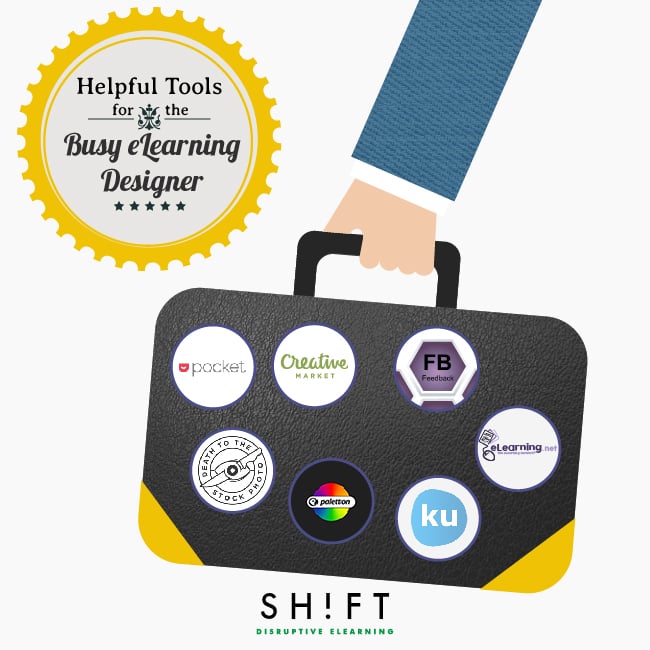Working in eLearning design can be overwhelming; eLearning designers spend many hours struggling to come up with the best possible design. It may seem like adding more programs and apps to the designer's kit can't possibly be the solution, but well-structured time management and handy tools make the difference between eLearning projects that cost and eLearning projects that benefit.
We know busy eLearning professionals want to know all about trying to maximize their time to address the many competing and yet vitally important priorities in front of them. So, here are some tips and tricks to keep on top of things.

1. Save inspiration with Pocket.
When you find a useful article but don't have time to read it right away, you can save it to Pocket instead. Then, access what you've saved later, online or offline, anytime and anywhere. A great application for capturing ideas.
2. Find quality graphics in Creative Market.
Creative Market features thousands of graphics, charts, themes, and fonts from independent design artists around the world. It's an excellent place to look for top quality content to spice up your eLearning courses, presentations, or even your CV.
3. Get better stock photos with Death To The Stock Photo and PlaceIt.
Finding good stock photos for eLearning design can be a pain, but these sites make it easier. Death To The Stock Photo will email you free stock photos monthly, while PlaceIt allows you to make your own. Either way, you can say goodbye to those low-res amateur photos.
4. Keep your workflow clear with the Periodic Table of Instructional Design.
This fun graphic, modeled after the Periodic Table of the Elements, makes a great checklist of techniques. Click through for more information about instructional techniques and advice about which to use when.
5. Boost effectiveness by following the Serious eLearning Manifesto.
The eLearning Manifesto outlines twenty-two supporting principles to be used as a base for eLearning design. Not particularly groundbreaking, but a good outline to consult if you're just starting out, or to use as a checklist for the more experienced to make sure your lesson is the best it can be. The site also provides guides for improving team collaboration by making workflows and files easy for other team members to use.
6. Use this short Proofreading Checklist to double-check your work.
Checking work for spelling, punctuation, grammar, and consistency is critical to producing eLearning content. Proofing errors make learners question the content's accuracy and the instructor's qualifications. A few minutes of cautious effort can add serious value to your product.
Also take note of these free proofreading tools:
7. Create vivid color schemes with Paletton and Kuler.
Coming up with color schemes that are eye-catching but not eye-searing can be tricky, and that's where both these sites come in: they will help you select contrasting and complementary colors. Remember, despite the number of options don't go overboard in your design: three fonts (title, body, accent), three colors (primary, complementary, accent), and two slide layouts (transition and content).
8. Keep recurring content together.
Some design elements, like logos and icons, tend to repeat from project to project out of necessity. Rather than go searching through old project files each time, place all these elements in a single Photoshop or Illustrator document and label it clearly. That way, you can get to them easily for future projects.
Also, create a filing system to archive and manage learning content for your resources such as audio, video, images, reference materials and documents. These are items you will use over and over and knowing exactly where to find them cuts down on the time you spend hunting for the content.
9. Storyboard, don't outline.
Linear outlines work well for papers, but eLearning design requires you to think about presentation as well as content, and traditional text-only outlining doesn't cover that, leading to delays and disorganization as you try to add visuals after the fact. Like in film and animation, storyboarding encourages you to think about not only the content, but the design.
- Use this free storyboard template from eLearning.net.
- Read through this list of 32 free storyboard templates and choose the one that best fits your needs.
- Create your own storyboard with Storyboard That.
Good luck and happy designing!





